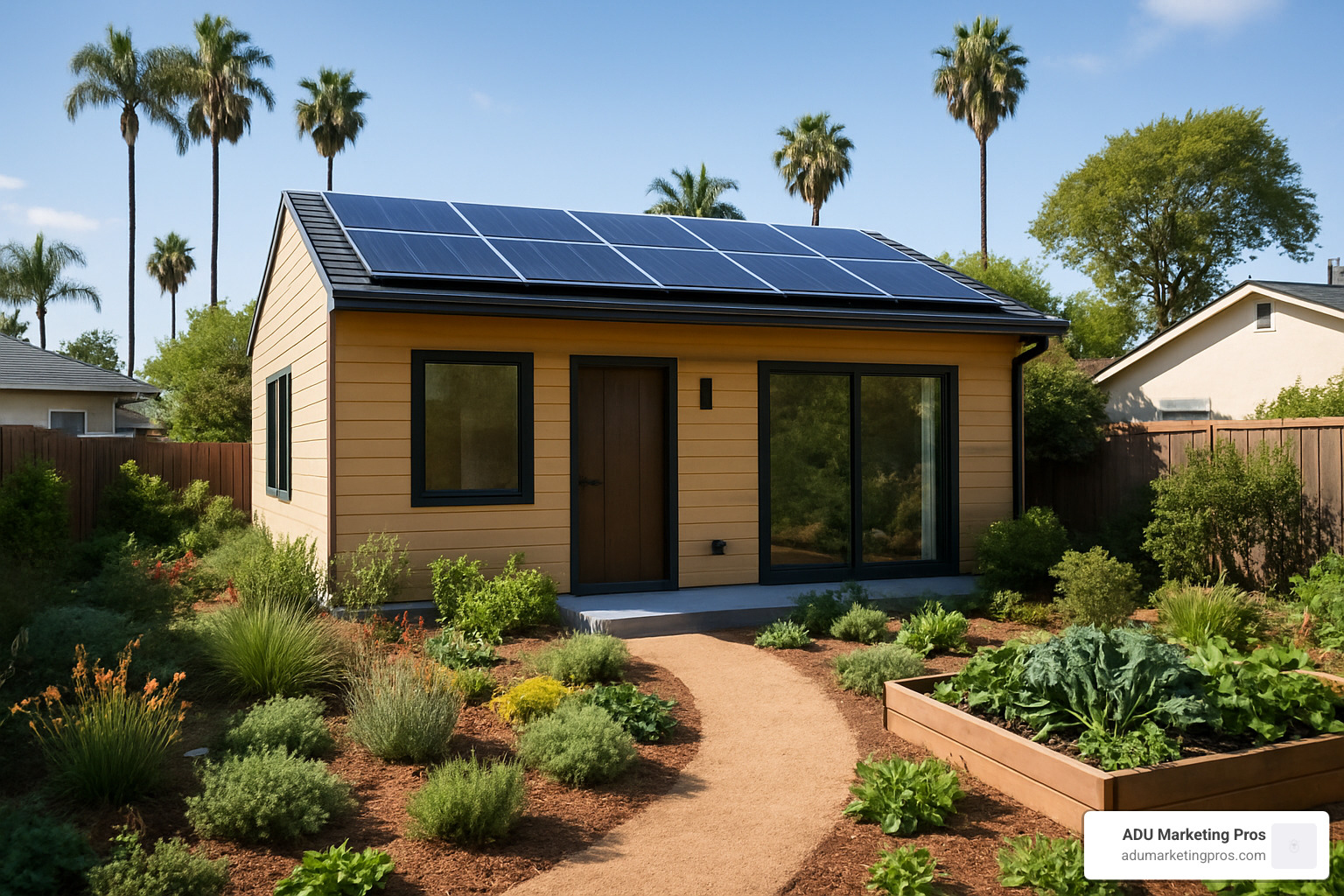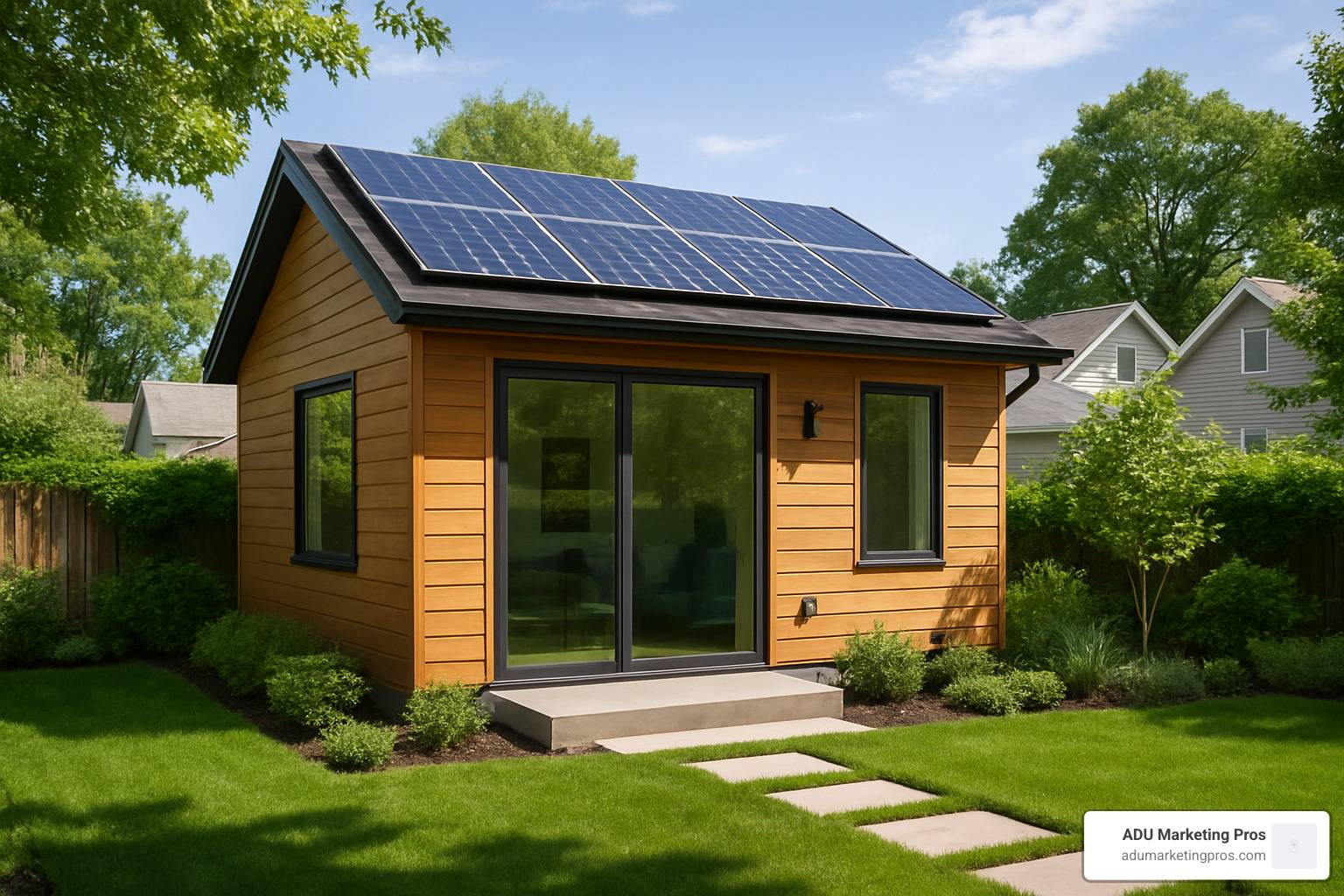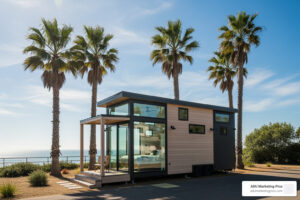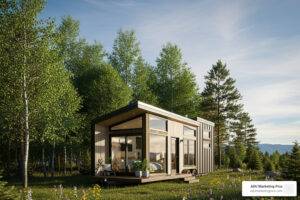The Future of Urban Housing: Smart, Small & Sustainable
An energy-efficient ADU (Accessory Dwelling Unit) is a small, self-contained secondary housing unit built on the same property as a single-family home that minimizes energy consumption through advanced design, materials, and systems.
Key Elements of Energy-Efficient ADUs:
- High-Performance Building Envelope – Well-insulated walls (R-19+), ceilings (R-38+), and foundations with minimal thermal bridging
- Energy-Efficient Windows & Doors – Double or triple-glazed windows with low-E coatings (U-factor ≤ 0.30)
- Efficient HVAC – Ductless mini-split heat pumps that use 72% less energy than conventional systems
- Renewable Energy – Rooftop solar PV systems saving approximately $1,500 annually
- Smart Technology – Programmable thermostats, energy monitoring, and efficient LED lighting
- Water Conservation – Low-flow fixtures saving up to 2,700 gallons of water annually
The demand for energy-efficient ADUs is surging across America, with an estimated 1.4 million units already in existence and growing rapidly. These compact, sustainable living spaces are revolutionizing how we think about housing in an era of climate consciousness and urban density challenges.
Building an energy-efficient ADU is more than just adding square footage to your property—it’s a strategic investment that can increase your home’s value by up to 35% while reducing your environmental footprint. As energy costs continue to rise and climate considerations become more urgent, these eco-friendly backyard homes represent a practical solution for homeowners looking to maximize their property’s potential while minimizing environmental impact.
“Energy-efficient building is doable—it just requires deliberate planning and deliberate thought,” says Aurora Ferrari, who built one of Washington D.C.’s first net-zero ADUs.
Whether you’re considering an ADU as a rental property, a space for aging parents, or a sustainable guest house, incorporating energy efficiency from the beginning will ensure lower utility bills, greater comfort, and a smaller carbon footprint for decades to come.
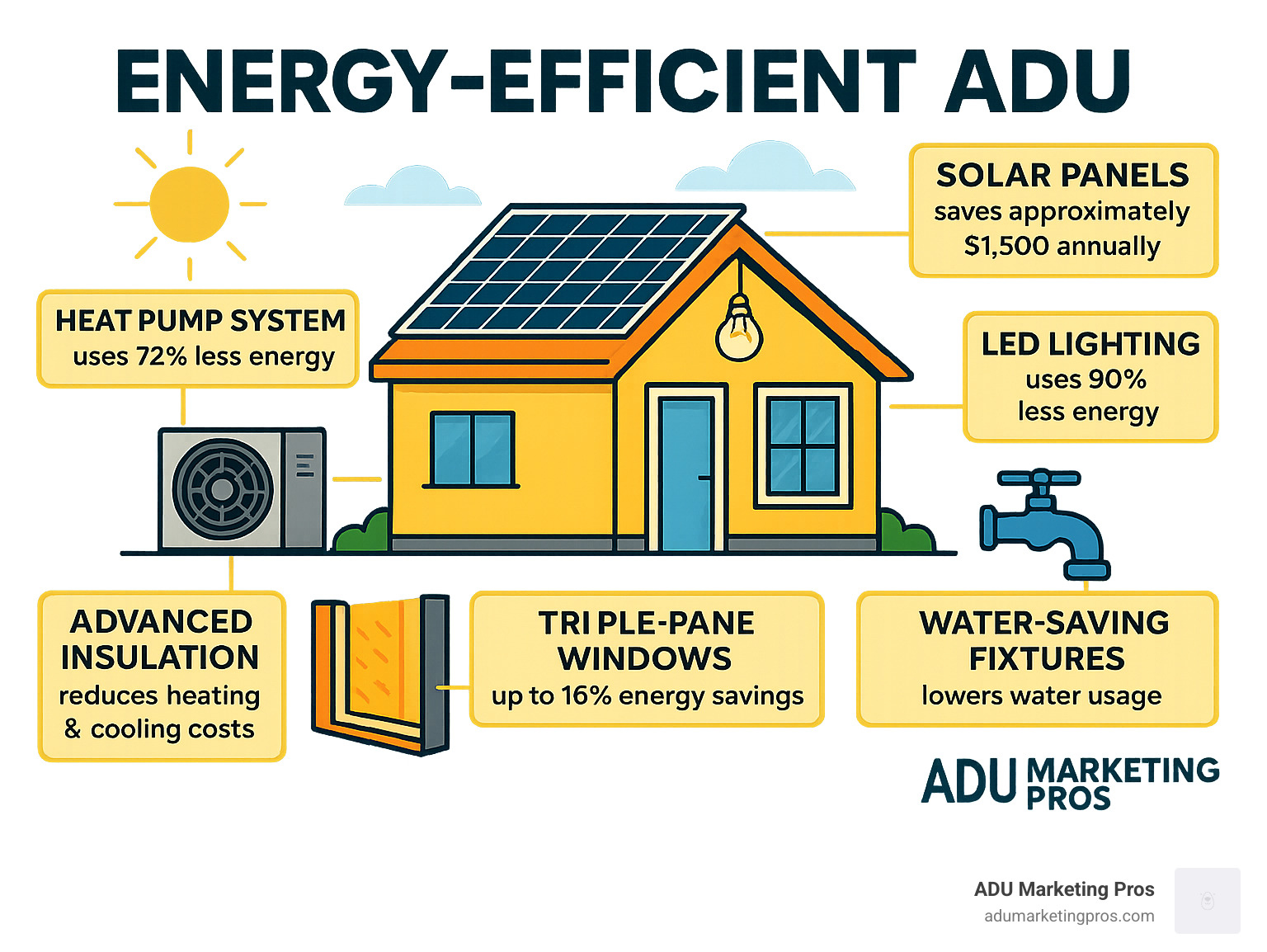
Why read this guide?
If you’re a homeowner in California—particularly in the San Jose, Sunnyvale, or broader Bay Area—this guide is your roadmap to navigating the booming ADU market with sustainability in mind. The Golden State continues to lead the nation in progressive ADU policies, with recent legislation making it easier than ever to add these structures to your property.
At ADU Marketing Pros, we’ve seen how the demand for sustainable backyard homes has skyrocketed, especially in our San Jose market where housing pressures and environmental consciousness intersect. This comprehensive guide will help you understand not just what makes an ADU energy-efficient, but how to actually build one that meets California’s stringent energy codes while maximizing comfort and minimizing ongoing costs.
What Is an Energy-efficient ADU?
An energy-efficient ADU is a secondary dwelling unit that sips energy instead of guzzling it. These cozy, self-contained living spaces pack all the essentials—kitchen, bathroom, living area, and sleeping space—into a thoughtfully designed package that uses dramatically less energy than conventional construction.
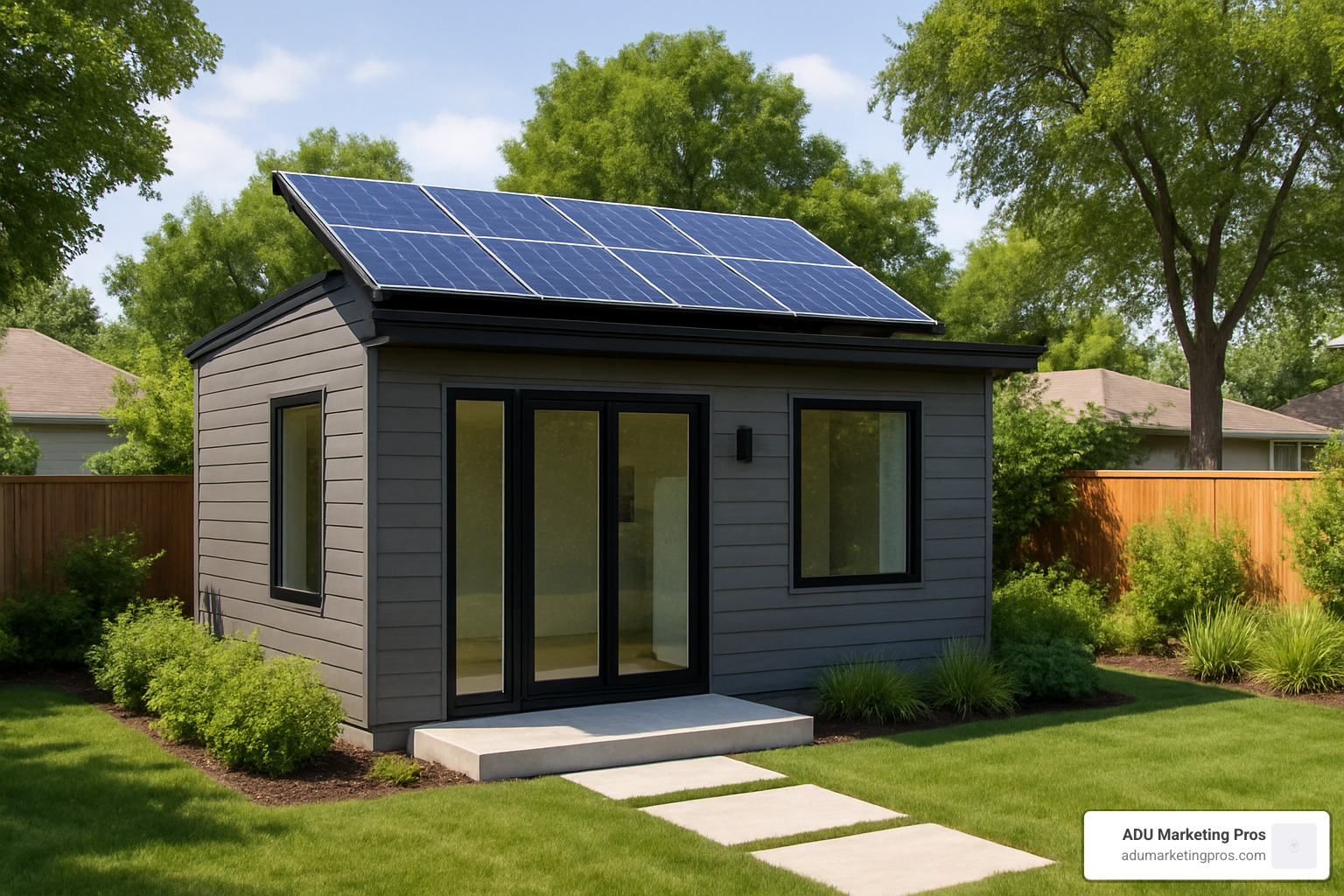
What sets an energy-efficient ADU apart from a standard backyard cottage isn’t just its size (typically 400-1,200 square feet), but the intention behind every design decision. From the moment pencil hits paper, these dwellings are crafted to minimize waste, slash utility bills, and create supremely comfortable living environments with the lightest possible environmental footprint. The most advanced models can achieve near net-zero energy performance—producing almost as much energy as they consume through smart design and renewable energy systems.
Think of it as the difference between a gas-guzzling SUV and a Tesla—they both get you where you’re going, but one is designed with efficiency as its core principle.
Different ADU formats & efficiency impact
Your energy-efficient ADU journey can take several paths, each with unique efficiency advantages:
Converting your basement or garage into an interior ADU offers instant efficiency wins by utilizing existing structure and reducing exterior wall exposure. The downside? These conversions sometimes struggle with natural light and ventilation—essential elements for both energy efficiency and livability.
Attached ADUs that extend from your main home share at least one wall with the primary dwelling, creating an efficiency advantage by reducing exterior wall area. This means less heat loss in winter and less heat gain in summer. They can also easily tap into existing utility systems, though the connection point between structures requires careful attention to avoid creating thermal bridges.
If you have the space, detached ADUs offer the greatest design flexibility. While they have more exposed surface area, they can be positioned for optimal solar orientation and designed from scratch with energy efficiency in mind. Modern prefab options deliver exceptional performance through precision factory construction that eliminates the air leaks common in site-built homes.
For the space-constrained, Junior ADUs (JADUs) of up to 500 square feet located within your home’s existing footprint can be remarkably efficient due to their compact size and shared walls, though design options are more limited.
Fortunately for Californians, recent legislation like Senate Bill 1051 and House Bill 2001 has dramatically expanded ADU rights, making it easier than ever to add these energy-efficient living spaces to your property, regardless of which format works best for your situation.
Key economic, social & environmental benefits
Building an energy-efficient ADU delivers a trifecta of benefits that extend far beyond your property line.
On the economic front, these small but mighty structures pack a powerful financial punch. Your property value could jump by as much as 35% according to the National Association of Realtors—a substantial return on investment in high-value markets like San Jose. About half of ADU owners generate steady rental income that can help offset mortgage costs or fund retirement. The efficiency features dramatically reduce monthly utility expenses, with potential savings exceeding $1,500 annually through solar integration alone. And that’s before factoring in the generous tax incentives and rebates available for energy-efficient construction.
The social benefits are equally compelling. As one homeowner told us, “My mother maintains her independence while being close enough that I can check on her daily—it’s the perfect balance.” Indeed, energy-efficient ADUs excel at supporting multigenerational living arrangements that keep families connected while respecting everyone’s need for personal space. They also increase housing affordability in expensive markets without changing neighborhood character. These adaptable spaces evolve with your family’s changing needs—from young adult housing to home office to rental unit—providing flexibility that conventional housing often lacks.
Environmentally, the benefits multiply. The smaller footprint naturally results in reduced resource consumption both during construction and throughout the building’s life. Energy-efficient ADUs typically use up to 72% less energy for heating and cooling than conventional construction, substantially lowering their carbon footprint. By increasing density in existing neighborhoods, they reduce transportation emissions and decrease strain on municipal infrastructure. Many are also designed with climate resilience in mind, offering better protection during extreme weather events and power outages through superior insulation, efficient systems, and potentially off-grid capabilities.
As Portland ADU owner Stephanie Dyer beautifully summarized: “I think ADUs speak to a lot of values: creative problem solving, smart and effective planning, and community mindfulness.” This sentiment resonates particularly strongly in environmentally conscious communities across California, where homeowners increasingly see energy-efficient ADUs as a practical way to align their housing choices with their values.
Designing an Energy-efficient ADU Building Envelope
The building envelope—that crucial barrier between the cozy interior and the outside world—is really the heart and soul of any energy-efficient ADU. It’s like the coat your ADU wears year-round, and getting it right from the start saves headaches down the road. After all, trying to upgrade insulation or air sealing after construction is a bit like trying to add a lining to a coat you’re already wearing—awkward and expensive!
Best materials & construction methods
When selecting materials for your energy-efficient ADU, you’re making choices that affect both your carbon footprint today (through manufacturing) and your energy bills for decades to come. The good news? You’ve got fantastic options.
Mass timber is becoming the darling of sustainable construction, and for good reason. Products like cross-laminated timber don’t just look beautiful—they actually store carbon while providing excellent thermal properties. I visited the Beech Haus ADU in Portland last year and was struck by their stunning glue-laminated Douglas fir stairwell. It’s not just a structural element but a conversation piece that happens to be incredibly eco-friendly.
Fiber-cement siding has become the go-to exterior choice for many California energy-efficient ADUs. Unlike vinyl (which can release toxins when heated), fiber-cement stands up to our climate beautifully—resisting fire, pests, and moisture while requiring minimal maintenance. One San Jose homeowner told me, “After the 2020 wildfires came so close, switching to fiber-cement for our ADU was a no-brainer.”
If you’re committed to truly sustainable building, consider avoiding materials on the Living Building Challenge’s “Red List”—things like PVC, formaldehyde, and halogenated flame retardants. Your indoor air quality will thank you, and you’ll sleep better knowing your ADU isn’t off-gassing harmful chemicals.
Here’s a quick comparison of wall systems to consider:
| Wall Assembly Type | R-Value | Air Tightness | Cost Per Sq Ft | Embodied Carbon | Installation Time |
|---|---|---|---|---|---|
| 2×4 @ 16″ w/ fiberglass | R-13 | Poor-Moderate | $$ | Moderate | Standard |
| 2×6 @ 24″ w/ cellulose | R-20 | Moderate | $$ | Low | Standard |
| SIPs 6.5″ | R-24+ | Excellent | $$$ | Low-Moderate | Fast |
| ICF 6″ | R-22+ | Excellent | $$$$ | High | Moderate |
| Mass Timber w/ ext. insulation | R-20+ | Good | $$$$ | Very Low | Moderate |
Structural Insulated Panels (SIPs) deserve special mention here. These prefabricated sandwich panels combine structure and insulation in one tidy package. The result? An incredibly airtight envelope with minimal thermal bridging. When I toured a SIP-built ADU in Sunnyvale last summer, the owner showed me their utility bills—about 40% lower than their neighbor’s similarly-sized conventional construction.
Prefab & modular advantages
There’s something magical about watching a prefab energy-efficient ADU come together. What might take months with traditional construction can happen in days—like architectural LEGO for grown-ups!
“We went from an empty backyard to a fully enclosed structure in eight hours,” recalls Miguel Santos, who installed a prefab ADU in San Jose last year. “The precision was incredible—you could barely see the seams where modules connected.”
That precision translates directly to energy performance. While a typical site-built home might leak air at a rate of 4-7 air changes per hour (ACH), prefab units regularly achieve 1-2 ACH or better. This tightness means your heating and cooling stay where they belong—inside your ADU.
The waste reduction is equally impressive. Traditional construction can send up to 40% of materials to landfills, while prefab manufacturing typically reduces waste by 90%. Factories can optimize cutting patterns and recycle scraps in ways that aren’t practical on a job site.
One creative homeowner I met, Jodi Jacobson-Swartfager from Portland, took a hybrid approach by converting a prefabricated Tuff Shed into a stylish, energy-efficient ADU. With proper insulation upgrades and careful air sealing, even basic prefab structures can become comfortable, efficient homes.
For more information about the growing world of modular ADU options, check out our detailed guide at ADU Modular Homes.
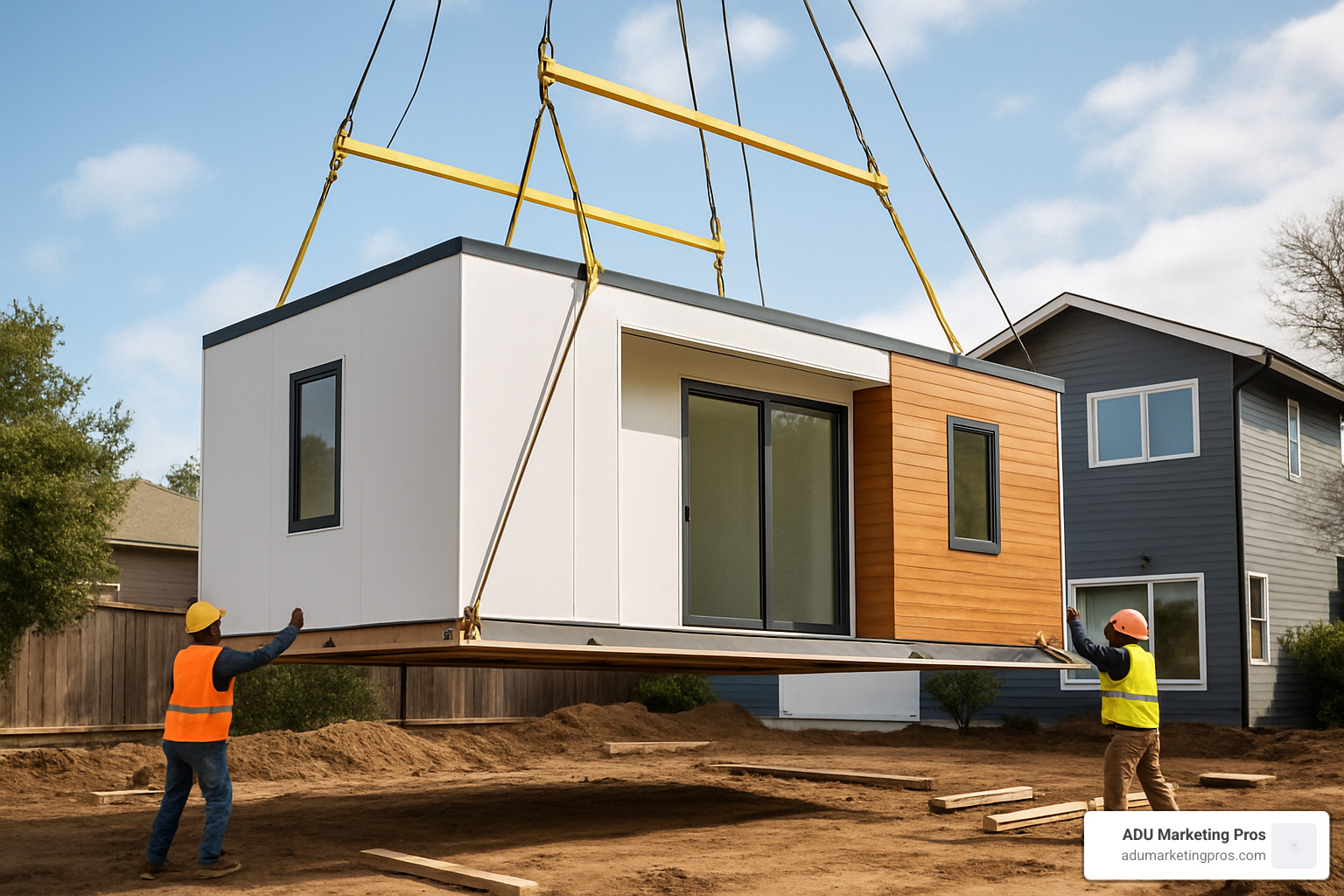
Water-wise design
In California, being energy-efficient means being water-wise too. After all, moving, treating, and heating water accounts for nearly 20% of the state’s electricity use. Your energy-efficient ADU can incorporate thoughtful water conservation from day one.
Start with the fixtures that matter most. A WaterSense-certified showerhead delivers a satisfying shower while saving about 2,700 gallons annually compared to standard models. When I upgraded my own bathroom, I was amazed that I couldn’t tell the difference in shower pressure—but I certainly noticed the drop in my water bill!
The hidden hero of water efficiency might be the humble recirculating hot water pump. These ingenious devices ensure hot water arrives at your tap almost instantly, eliminating that wasteful wait while perfectly good water goes down the drain. They use less electricity than a 25-watt light bulb while saving thousands of gallons annually.
Outside your ADU, consider embracing xeriscaping—landscaping that requires little or no irrigation beyond natural rainfall. Native California plants not only save water but create habitat for local pollinators. One San Jose ADU owner transformed the surrounding yard with drought-resistant sages, manzanita, and California lilac—creating a beautiful, low-maintenance landscape that needs watering just a few times a year.
The average household wastes approximately 180 gallons weekly from leaks alone. Quality fixtures and careful installation eliminate this waste while reducing the energy needed to heat water—a perfect example of how water efficiency and energy efficiency go hand in hand in a well-designed ADU.
High-Performance Technologies & Systems for an Energy-efficient ADU
When building your energy-efficient ADU, the systems and technologies you choose will make all the difference in day-to-day performance. Think of these components as the heart and lungs of your space—they’ll determine not just how efficiently it runs, but how comfortable it feels to live in.
Heat pumps have revolutionized the way we approach climate control in small spaces. Ductless mini-split heat pumps are particularly amazing for ADUs because they transfer heat rather than generating it. This means they can achieve efficiencies of 300-400% compared to traditional resistance heating—delivering 3-4 units of heating or cooling for every unit of electricity consumed. That’s like getting three dollars of value for every dollar spent!
For homeowners willing to make a larger upfront investment, geothermal heat pumps offer even more impressive savings. According to the latest research from the Department of Energy, these systems can slash energy bills by up to 72% compared to conventional HVAC. Even better, they’re incredibly durable, with the heat pump typically lasting 20+ years and the ground loops often lasting 50+ years or more.
Fresh air is essential in a tightly-sealed modern ADU, which is where Energy Recovery Ventilators (ERVs) shine. These clever systems recover 60-95% of the heat or coolness from exhaust air while bringing in fresh outdoor air. It’s like opening your windows for fresh air without losing all your heated or cooled air in the process.
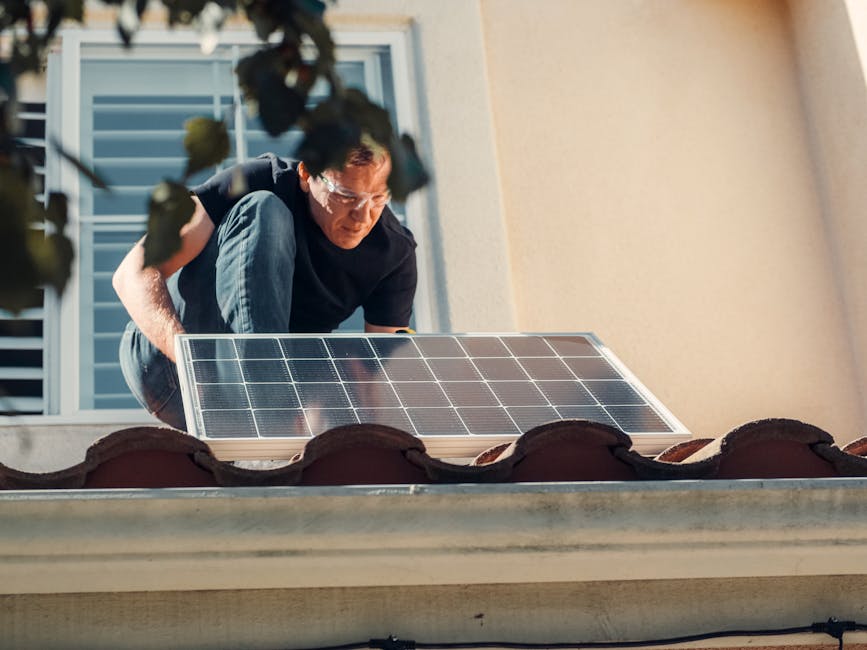
California’s 2022 Energy Code has given a strong push toward rooftop solar PV for ADUs, and with good reason. These systems typically pay for themselves within 5-7 years while significantly reducing carbon emissions. Aurora Ferrari’s Washington D.C. ADU achieved net-zero status with just 13 solar panels—proof that even modest systems can make a huge difference in a well-designed small space.
It’s worth noting that new ADUs in California must now be “battery-ready” with appropriate electrical infrastructure. This forward-thinking requirement makes it easy to add energy storage later, which will become increasingly valuable as our grid evolves and extreme weather events become more common.
For hot water needs, solar water heating systems can provide up to 80% of your requirements. At around $4,000 with typical 10-year warranties, they’re a practical addition to many energy-efficient ADU projects.
When it comes to lighting, LEDs are the clear winner, operating up to 90% more efficiently than old-school incandescent bulbs. But don’t overlook the power of natural light! Strategic daylighting can reduce lighting loads by 20-60%, while also providing psychological benefits. According to scientific research by the GSA, proper daylighting improves productivity and wellbeing for occupants.
For appliances, look for the ENERGY STAR label. These certified refrigerators, dishwashers, and washing machines use 10-50% less energy than standard models. And if you’re outfitting a kitchen, consider induction cooking—these sleek electric cooktops are approximately 85% efficient compared to 40% for gas, while eliminating indoor air quality concerns from combustion.
Indoor air quality & comfort
An energy-efficient ADU should feel like a breath of fresh air—literally. As we build tighter, more efficient envelopes, mechanical ventilation becomes non-negotiable. Without it, indoor air can become stale and potentially unhealthy.
Balanced ventilation systems ensure a continuous exchange of fresh air. For small ADUs under 500 square feet, simpler systems might be sufficient, but don’t be tempted to skip this critical component. Yes, a typical fresh-air ventilation system for a small ADU costs $8,000-10,000, but the dividends it pays in health and comfort are immeasurable.
Maintaining the right humidity level is another comfort essential. The sweet spot is between 40-60% relative humidity—this range minimizes mold growth while keeping respiratory systems happy. Your climate will determine whether you need to add or remove moisture from the air. The good news is that heat pump systems naturally provide excellent humidity control as a side benefit.
The materials inside your ADU matter tremendously. Specifying low-VOC materials for paints, adhesives, sealants, and finishes prevents off-gassing that can cause headaches or respiratory issues. Natural materials like cork flooring or Marmoleum (featured in several leading prefab ADU models) offer beautiful, healthy alternatives to vinyl or carpet.
For those in wildfire-prone regions or with allergy concerns, consider improved filtration systems. High-MERV filters (11+) can remove particulates, allergens, and some pathogens from recirculated air.
As passive house consultant Ed May wisely notes: “The basic strategies are very, very simple and they’re incredibly boring.” But these “boring” fundamentals—proper ventilation, moisture control, and material selection—create living spaces that feel remarkably different from conventional construction. Your ADU residents will notice the difference, even if they can’t quite put their finger on why the space feels so good.
Smart controls & monitoring
The intelligence built into your energy-efficient ADU can take its performance to the next level. Smart systems don’t just offer convenience—they prevent waste and optimize performance in ways that manual controls simply can’t match.
Load shifting capabilities allow your ADU to automatically run appliances or charge batteries when renewable energy is abundant or utility rates are lowest. As time-of-use electricity pricing becomes more common in California, this feature alone could save hundreds of dollars annually.
Ever left a light on in an empty room? Occupancy sensors solve this common energy waste by automatically adjusting lighting, ventilation, and temperature based on whether someone is present. This is particularly valuable in ADUs that might have variable occupancy patterns.
One of the most powerful tools for energy conservation is simple awareness. Energy dashboards providing real-time and historical usage data help occupants understand their consumption patterns. Studies consistently show that visible feedback alone can reduce energy use by 5-15%—people naturally use less when they can see their consumption.
For rental ADUs or guest quarters, remote access features are invaluable. The ability to control systems via smartphone allows property owners to adjust settings between tenants or when spaces are vacant, ensuring energy isn’t wasted heating or cooling an empty space.
These smart technologies create a responsive living environment that adapts to changing needs while minimizing waste—a perfect complement to the physical efficiency measures in your energy-efficient ADU.
Codes, Costs & Incentives
Navigating the regulatory landscape for your energy-efficient ADU might seem daunting at first, but understanding the codes while capitalizing on available incentives can make your project both compliant and affordable.
California’s 2022 Title 24 Energy Code, which kicked in on January 1, 2023, has brought some significant changes that directly impact ADU construction. The code now strongly favors efficient electric heat pumps over traditional gas heating systems, requires new ADUs to be “electric-ready” with appropriate infrastructure, and has expanded standards for solar and battery storage integration. It also puts greater emphasis on proper ventilation to ensure healthy indoor air quality.
How your ADU is classified matters tremendously for compliance purposes. A detached backyard cottage falls under “new construction” rules, while an ADU sharing walls with your main house follows “addition” standards. Converting your existing garage? That’s treated as an “alteration” with its own set of requirements.
“Understanding which compliance path works best for your specific project can save you thousands,” explains Maria Chen, an energy consultant who specializes in ADU projects in the Bay Area. “For some homeowners, the straightforward prescriptive path makes the most sense, while others benefit from the flexibility of the performance path, especially when incorporating innovative technologies.”
The good news is that California has followed Oregon’s pioneering ADU-friendly legislation (House Bill 2001 and Senate Bill 1051), making it much easier to get approval for your project. While local jurisdictions may still have specific requirements, the overall process has been dramatically streamlined. If you’re wondering whether your property qualifies for an ADU, the Symbium Build tool can quickly help you determine eligibility and applicable local regulations.
The financial picture for energy-efficient ADUs has never looked brighter, thanks to substantial federal incentives through the Inflation Reduction Act. These include a generous 30% tax credit for solar installation, up to $2,000 in tax credits for heat pump systems, and additional credits for battery storage, insulation upgrades, and high-performance windows.
California residents enjoy even more financial support through programs like The Switch Is On, which offers rebates for electrification projects. Your local utility likely provides additional incentives for efficient appliances and systems, and some forward-thinking municipalities even offer expedited permitting or reduced fees specifically for highly efficient ADUs.
Let’s talk dollars and cents. While an energy-efficient ADU typically costs 5-15% more upfront than conventional construction, the investment pays dividends in multiple ways: significantly reduced monthly utility bills (often 50-70% lower), increased property value, improved rental potential, greater comfort, better indoor air quality, and improved resilience during power outages or extreme weather events.

Aurora Ferrari’s experience building a net-zero ADU in Washington D.C. offers a realistic picture of what to expect. Her 600-square-foot project cost approximately $330 per square foot ($200,000 total), comparable to high-quality conventional construction in many California markets. The timeline? Two years from start to finish—nine months navigating permits and seven months for actual construction.
For those interested in geothermal options, the latest research on geothermal savings from the Department of Energy confirms these systems can deliver exceptional long-term value despite higher upfront costs.
When budgeting for your energy-efficient ADU, remember to factor in both the initial investment and the ongoing savings. Many homeowners find that the premium paid for high-performance features pays for itself through utility savings within 5-10 years, while they enjoy the benefits of a more comfortable, resilient home from day one.
“The most expensive ADU is the one you have to retrofit later,” notes building science expert Christine Williamson. “Building it right the first time always costs less in the long run.”
From Plan to Move-In: Step-by-Step Roadmap
Building an energy-efficient ADU isn’t just about following a checklist—it’s about creating a thoughtful living space that will serve you and the planet for decades to come. Let me walk you through the journey from initial concept to your first night in your new space.
Start with a thorough site assessment. Spend time in your yard at different times of day to understand how sunlight moves across your property. Where are the mature trees you want to preserve? How does water flow when it rains? The Symbium Build tool (a homeowner’s best friend in the ADU world) can help you verify zoning eligibility and understand setback requirements before you get too attached to a specific location.
When it comes to budgeting, investing in efficiency upfront pays dividends for years. Many homeowners I’ve worked with find that specialized ADU loan programs can make financing surprisingly manageable. Always build in that 10-15% contingency—even the most carefully planned projects encounter surprises when you start digging!
Finding the right design team makes all the difference. Look for professionals who light up when talking about energy efficiency, not those who treat it as an afterthought. If you’re considering prefab options (which often deliver exceptional performance due to factory precision), start those conversations early as production schedules can fill up months in advance. Your architect, energy consultant, and builder should be collaborating from day one, not working in silos.
The permitting phase tests everyone’s patience, but preparation makes a huge difference. Submit comprehensive plans with detailed energy calculations, and consider hiring a permit expediter if you’re in a jurisdiction known for complexity. One client in San Jose told me, “I wish I’d budgeted as much time for permitting as for construction!” That’s often not far from the truth.
When construction begins, quality control becomes your mantra—especially for elements that will be hidden behind walls. Insist on blower door tests before drywall goes up so air leaks can be addressed while they’re still accessible. Take photos of everything before walls are closed up; you’ll thank yourself later when trying to locate plumbing or wiring.
Testing and commissioning might seem like technical formalities, but they’re your assurance that systems will perform as designed. HERS testing isn’t just a code requirement—it’s validation that your investment will deliver the comfort and efficiency you’re paying for. Make sure your contractor properly calibrates all systems and teaches you how to use them effectively.
Once you’re ready for occupancy, create a simple owner’s manual for your ADU systems. Setting up energy monitoring from the beginning gives you fascinating insights into how your space performs through different seasons and activities. One Portland homeowner told me, “I became slightly obsessed with watching my energy dashboard during the first winter—it was like a game to see how efficient I could be!”
Common challenges & solutions
Even the most carefully planned energy-efficient ADU projects face problems. Here’s how to overcome them:
When faced with utility capacity limitations, think creatively. Many of my clients have avoided expensive panel upgrades by going all-solar or incorporating battery storage. Have this conversation with your electrician early—finding you need a service upgrade midway through construction can blow both budget and timeline.
Cost overruns happen, but smart prioritization saves the day. Focus your budget on the “thermal envelope” (insulation, windows, air sealing)—these elements are nearly impossible to upgrade later. You can always add that fancy smart thermostat next year, but you can’t easily add insulation to finished walls.
Finding contractors familiar with high-performance building techniques can be challenging. Rather than getting frustrated, see it as an opportunity to be specific about performance requirements rather than just products. One builder told me, “Working on my first energy-efficient ADU completely changed how I approach all my projects now.”
When material shortages threaten your timeline (an all-too-common reality these days), having a Plan B and even Plan C for key components is wise. Order long-lead items early, and consider locally produced materials when possible—they’re often better for the planet anyway.
If your code officials seem unfamiliar with newer energy-efficient systems, a little education goes a long way. Prepare simple explanations of how your heat pump or ERV works, and offer to walk them through unfamiliar details. Most officials appreciate the learning opportunity rather than seeing it as a challenge to their authority.
Real-world case studies
There’s nothing more inspiring than seeing how others have successfully steerd the energy-efficient ADU journey:
Case Study 1: The Beech Haus (Portland, Oregon)
What started as a humble backyard Tuff Shed change became a stunning 400-square-foot light-filled dwelling. The owner prioritized triple-pane windows that, while more expensive upfront, create an envelope of silence and comfort inside. An air-source heat pump replaced traditional forced-air heating, dramatically reducing energy use while providing consistent comfort. Strategic window placement turned what could have been a dark shed into a space bathed in natural light.
Owner Stephanie Dyer captures the spirit perfectly: “I think ADUs speak to a lot of Portland values: creative problem solving, smart and effective planning and community mindfulness.”
Case Study 2: Ferrari Net-Zero ADU (Washington D.C.)
When Aurora Ferrari decided to transform her 1920s garage into a 600-square-foot ADU, she wasn’t just aiming for energy efficiency—she wanted net-zero performance. By preserving the original stone walls while adding modern high-performance elements, she created a space with both character and incredible efficiency. Thirteen rooftop solar panels now generate all the electricity the ADU needs, while an airtight construction approach with dedicated ventilation ensures superb air quality.
Aurora emphasizes a fundamental truth: “Building airtightness is akin to creating a high-performance thermos and requires rigorous sealing and insulation.” Her two-year journey (nine months for permitting and seven months for construction) resulted in a living space that costs virtually nothing to operate.
Case Study 3: Habitat LA ADU
Proving that sustainability and affordability can go hand-in-hand, Habitat for Humanity of Greater Los Angeles created a 494-square-foot, one-bedroom ADU that serves as a model for accessible green building. The designers incorporated drought-tolerant landscaping that thrives in California’s climate while minimizing water usage. Inside, energy-efficient heating and cooling systems maintain comfort without excessive energy use.
The team made creative material choices, including recycled denim insulation that not only performs beautifully but gives new life to textile waste. By making the structure solar-ready, they ensured future renewable energy integration would be simple and cost-effective. This project powerfully demonstrates that energy efficiency isn’t a luxury feature—it’s achievable at all price points when prioritized from the beginning.
Looking to learn more about designing your own energy-efficient space? Check out our guide to current ADU design trends or explore modular ADU options that can streamline the building process.
Frequently Asked Questions about Energy-efficient ADUs
What is the typical payback period for solar on an ADU?
Wondering if solar makes financial sense for your energy-efficient ADU? Good news – in sunny California, most homeowners see their solar investment pay for itself in just 5-8 years. After that, it’s essentially free electricity for decades!
The math works especially well for ADUs because of their compact size. A typical backyard cottage might need only a modest 2-4 kW system, keeping upfront costs manageable. When you factor in California’s generous net metering program (which credits you for excess power your panels produce) and the substantial 30% federal tax credit, the numbers become even more attractive.
I spoke with a San Jose homeowner who installed solar on her ADU last year. “We’re saving about $125 a month on electricity,” she told me. “And there’s something deeply satisfying about watching our meter run backward on sunny days.” With modern panels warrantied for 25+ years and typically performing well for three decades or more, that’s a lot of free, clean energy after the initial payback period.
Can an ADU realistically achieve net-zero energy in cloudy regions?
Yes! Even in places where rain clouds are more common than blue skies, an energy-efficient ADU can still achieve net-zero status. The secret isn’t just adding more solar panels—it’s first dramatically reducing how much energy the building needs.
Think of it as a two-step dance: first minimize demand, then supply the remaining needs with renewables. In cloudy Portland, Oregon, numerous successful net-zero ADUs start with what builders call “superinsulation”—walls with R-values of 25 or higher, roofs exceeding R-40, and foundations at R-20+. Combine this with airtight construction (verified through blower door testing) and high-performance windows, and you’ve created a structure that needs remarkably little energy to maintain comfort.
“My ADU in Seattle uses about 70% less energy than a conventional build of the same size,” explains Michael Tobias, who built a net-zero backyard cottage in 2021. “That means even with our notorious gray skies, my modest solar array can cover all my needs.” The practical reality is that ADUs in cloudier regions might need 25-30% more solar capacity than those in sunny Southern California, but the goal remains entirely achievable.
How do California’s Title 24 requirements differ for additions vs new detached ADUs?
Navigating California’s Energy Code (Title 24) can feel like learning a new language, but understanding the distinctions between different ADU types makes a big difference in your planning.
Newly Constructed ADUs (Detached) face the most comprehensive requirements. These standalone structures must comply with all standards for new residential construction, including solar PV requirements based on floor area, electric-ready provisions, and Energy Storage System (ESS) readiness. Think of these as mini-houses that must meet all the same energy standards as a full-sized new home.
Addition ADUs (attached to your main house) get a bit more flexibility. The solar PV requirements might be reduced or waived, and if your addition is under 700 square feet, you’re exempt from Quality Insulation Installation (QII) requirements. There’s also some wiggle room to match existing construction elements, though all new components still need to meet minimum efficiency standards.
For Alteration ADUs (like garage conversions), the focus shifts to new systems and modified building components. Existing elements can often be grandfathered in if you’re not substantially changing them, though proper ventilation and energy-efficient lighting remain mandatory.
For all ADU types, you have two paths to compliance:
1. Prescriptive: Following specific requirements for each building element (simpler but less flexible)
2. Performance: Using energy modeling to demonstrate equivalent or better efficiency (more complex but allows creative solutions)
“The prescriptive path is like following a recipe exactly,” explains Elena Rodriguez, a Title 24 consultant in San Jose. “The performance path is more like being told what the dish should taste like, but you can adjust the ingredients as long as the result meets the standard.”
For detailed guidance, the California Energy Commission’s Online Resource Center and Energy Code Ace offer invaluable assistance to steer these requirements.
Conclusion
There’s something special about building an energy-efficient ADU. It’s not just about adding square footage to your property—it’s about creating a thoughtful living space that’s comfortable, practical, and kind to both your wallet and the planet.
Throughout California, especially in competitive housing markets like San Jose and the Bay Area, these small but mighty structures are proving their worth daily. They’re providing rental income for homeowners, creating comfortable spaces for aging parents, and offering flexible solutions as our needs change over time. By baking energy efficiency into these spaces from day one, you’re making an investment that becomes more valuable with each passing year as energy costs continue to climb and climate considerations become increasingly urgent.
Don’t let the technical aspects intimidate you. As ADU owner Aurora Ferrari wisely put it, “Energy-efficient building is doable—it just requires deliberate planning and deliberate thought.” Today’s growing ecosystem of designers, builders, and prefab manufacturers who specialize in sustainable ADUs makes turning your backyard dreams into reality more accessible than ever before.
At ADU Marketing Pros, we’re passionate about supporting the growth of sustainable housing solutions across California. Our team understands the unique challenges faced by architects, builders, and developers who specialize in energy-efficient construction. We help these professionals communicate their expertise and connect with homeowners who understand that quality, sustainability, and long-term thinking are worth more than just chasing the lowest initial price tag.
The future of housing isn’t some distant concept—it’s being built right now in backyards throughout California. When you choose to create an energy-efficient ADU, you’re joining a housing revolution that values sustainability, community integration, and adaptability. The choices you make today will leave a lasting legacy: lower carbon emissions, reduced energy bills, and improved comfort that will benefit generations to come.
Ready to start planning your energy-efficient ADU? There’s never been a better time to explore your options and become part of the movement toward more sustainable, flexible housing solutions.
